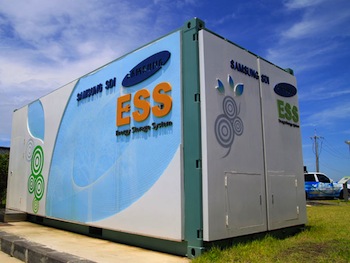 Europe's Biggest Energy Storage Project (Yet)Aug 05, 2013 - sustainablebusiness.com SustainableBusiness.com News The largest European energy storage experiment so far â involving a 6-megawatt (MW) lithium-ion battery - is under way in the UK. It's a collaboration between utility S&C Electric Europe, high-tech firm Samsung SDI and energy management company Younicos that the three partners believe will save up to $9 million on upgrades, such as replacing transmission lines and transformers. The four-year-long project at the Leighton Buzzard substation in eastern England will use a massive Smart Network Storage battery from Samsung SDI. The goal is to ease capacity restraints and to improve ways of connecting clean intermittent sources such as wind and solar onto the grid. The local distribution operator, UK Power Networks, is leading the project.
âThe major grid challenges from the UKâs decarbonization can be met through energy storageâs inherent ability to reinforce the network," says Andrew Jones, Managing Director, S&C Electric Europe. "But currently there are limited large-scale energy storage projects here, leaving a confidence gap. This practical demonstration promises to show the strengths and limitations of storage and unlock its potential as a key technology for the transition to low carbon energy.â The project is supported by $20 million in funding under the UK's Low Carbon Networks Fund, managed by the Office of Gas and Electricity Markets (Ofgem). The total cost of the test will run about $29 million. âIf we are serious about transitioning to a renewables-based energy economy, adding more, and intelligent, storage to the grid quickly is key," says Clemens Triebel, founder and speaker of the board of Younicos. "Thatâs why weâre proud to contribute to this groundbreaking projectâs success through our intelligent control algorithms and experience in frequency regulation and battery management. Weâre eager to show how industrially available batteries can be integrated into existing grids economically today, and help effectively balance intermittent renewable generation, allowing us to switch off CO2-intensive thermal plants when they arenât needed.â By deploying 2 gigawatts (GW) of energy storage, the UK could save $4.6 billion annually by the 2020s -- the savings go up as the proportion of renewable energy as a total of the nation's overall power portfolio rises, according to research from Imperial College. Energy storage is become an increasingly critical component of renewable energy investments. In February, Germany started offering feed-in tariffs (FiT) to encourage the installation of energy storage alongside solar arrays. In California, the public utilities commission has hinted it will make this technology a standard part of future solar plants. The UK project may be the biggest one in Europe but there are bigger ones elsewhere. In China, a battery bank the size of a football field can store up to 36 megawatt-hours of power from a nearby 140 MW wind and solar plant. Duke Energy has invested in a similar-sized installation for a wind farm in Texas. But the biggest one yet is a 60 MW battery bank being installed in Japan, slated to be operational by 2015. |
Email this page to a friend
If you speak another language fluently and you liked this page, make
a contribution by translating
it! For additional translations check out FreeTranslation.com
(Voor vertaling van Engels tot Nederlands)
(For oversettelse fra Engelsk til Norsk)
(Для дополнительных
переводов проверяют
FreeTranslation.com )


